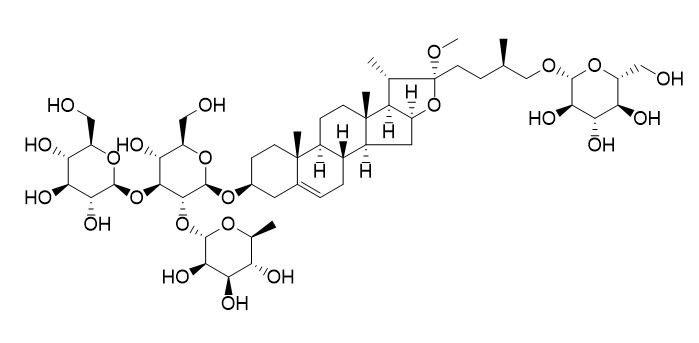Methyl protogracillin
Methyl protoneogracillin shows cytotoxic activitiy against the cancer cell line of K562 in vitro as antineoplastic agents. It can cause morphological abnormality of Pyricularia oryzae mycelia.
Inquire / Order:
manager@chemfaces.com
Technical Inquiries:
service@chemfaces.com
Tel:
+86-27-84237783
Fax:
+86-27-84254680
Address:
1 Building, No. 83, CheCheng Rd., Wuhan Economic and Technological Development Zone, Wuhan, Hubei 430056, PRC
Providing storage is as stated on the product vial and the vial is kept tightly sealed, the product can be stored for up to
24 months(2-8C).
Wherever possible, you should prepare and use solutions on the same day. However, if you need to make up stock solutions in advance, we recommend that you store the solution as aliquots in tightly sealed vials at -20C. Generally, these will be useable for up to two weeks. Before use, and prior to opening the vial we recommend that you allow your product to equilibrate to room temperature for at least 1 hour.
Need more advice on solubility, usage and handling? Please email to: service@chemfaces.com
The packaging of the product may have turned upside down during transportation, resulting in the natural compounds adhering to the neck or cap of the vial. take the vial out of its packaging and gently shake to let the compounds fall to the bottom of the vial. for liquid products, centrifuge at 200-500 RPM to gather the liquid at the bottom of the vial. try to avoid loss or contamination during handling.
Foods.2021, 10(11):2627.
Integr Cancer Ther.2018, 17(3):832-843
Nutrients.2018, 11(1):E17
Separations2023, 10(4),255.
Plant Cell Tiss Org2017, 479-486
Integr Med Res.2024, 13(1):101025.
RSC Adv.2023, 13(9):6317-6326.
Drug Dev Res.2020, doi: 10.1002
Regul Toxicol Pharmacol.2023, 142:105433.
Molecules.2024, 29(3):671.
Related and Featured Products
Phytother Res. 2003 Jun;17(6):620-6.
The cytotoxicity of methyl protoneogracillin (NSC-698793) and gracillin (NSC-698787), two steroidal saponins from the rhizomes of Dioscorea collettii var. hypoglauca, against human cancer cells in vitro.[Pubmed:
12820229]
In our continuous studies of anticancer activity of steroidal saponins from the rhizomes of Dioscorea collettii var. hypoglauca (Dioscoreaceae), methyl protoneogracillin (NSC-698793) and gracillin (NSC-698787) were tested for cytotoxicity against human cancer cell lines from leukemia and eight solid tumor diseases.
METHODS AND RESULTS:
As a result, methyl protoneogracillin was cytotoxic against all the test cell lines with GI(50) < 100 micro M, especially selectively against two leukemia lines (CCRF-CEM and RPMT-8226), one colon cancer line (KM12), two central nervous system (CNS) cancer lines (SF-539 and U251), one melanoma line (M14), one renal cancer line (786-0), one prostate cancer line (DU-145), and one breast cancer line (MDA-MB-435), with GI(50) < or = 2.0 micro M. Leukemia, CNS cancer, and prostate cancer were the most sensitive subpanels, while ovarian cancer was the least sensitive subpanels. The preliminary toxicity studies showed that the maximum tolerant dose was 600 mg/kg for methyl protoneogracillin to mice. Gracillin was cytotoxic against most cell lines with GI(50), TGI and LC(50) at micromolar levels, but no activity against EKVX (non-small cell lung cancer), HT29 (colon cancer), OVCAR-5 (ovarian cancer), and SN12C (renal cancer). Based on structure-activity relationship, C-25 R/S con fi guration was critical for leukemia selectivity between methyl protoneogracillin and Methyl protogracillin. F-ring was critical to selectivity between furostanol (methyl protoneogracillin and Methyl protogracillin) and spirostanol (gracillin) saponins in this study.
CONCLUSIONS:
By an analysis of COMPARE software, no compounds in the NCI's database had similar mean graphs to those of methyl protoneogracillin and gracillin, respectively, indicating potential novel mechanism(s) of action involved. Put all in together, methyl protoneogracillin has been selected as a potential anticancer candidate for hollow fi ber assay to nude mice, but gracillin will not be pursued due to lack of selectivity against human cancer diseases.
Planta Med. 1997 Apr;63(2):161-5.
Antineoplastic agents. II. Four furostanol glycosides from rhizomes of Dioscorea collettii var. hypoglauca.[Pubmed:
17252340 ]
METHODS AND RESULTS:
During activity-guided fractionations to screen for antineoplastic agents, further studies by means of preparative HPLC led to the isolation of four known furostanol saponins: protoneodioscin, protodioscin, protoneogracillin, protogracillin, along with their corresponding artifacts: methyl protoneodioscin, methyl protodioscin, methyl protoneogracillin, and Methyl protogracillin, from the rhizomes of Dioscorea collettii var. hypoglauca. Among them, protoneodioscin, protodioscin, and protoneogracillin are first reported from the title plant. The structures of the compounds were established on the basis of chemical evidence and spectral analysis (1H-NMR, 13C-IMMR, 1H-1H COSY, HMQC, HMBC, and FAB-MS).
CONCLUSIONS:
These eight compounds all caused morphological abnormality of Pyricularia oryzae mycelia. They also showed cytotoxic activities against the cancer cell line of K562 in vitro as antineoplastic agents.



